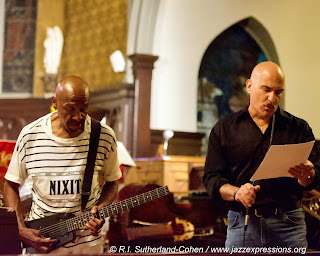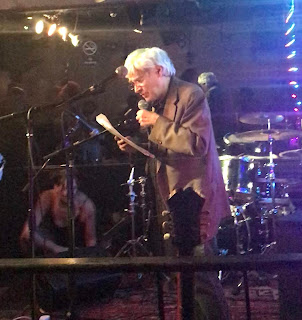Published in The Wire August
2019 (with subtitle "Drumming up support")
RONNIE BURRAGE: Music of Reckoning and
Awakening
by John Pietaro
Ronnie Burrage sits at the house drumkit
of Sista’s Place, the noted jazz haunt in Bedford-Stuyvesant, Brooklyn, leading
eloquently from behind. A multi-instrumentalist wielding formidable piano
skills, the kit bears an electronic keyboard hovering over its floor tom.
Burrage tosses right-handed chords into the harmonic structure while
maintaining a torrential rhythmic onslaught across three limbs. The evening,
one of several the drummer crafted in honor of the late Hamiett Bluett, ignites
the capacity crowd. The band’s riveting take on Bluett’s classic “Oasis” culminates
in a tireless montuno peppered by crushing accents which threaten, it seems,
the very foundation of the room.

Hailing from St. Louis, Missouri, Ronnie Burrage came
of age during the height of the Black Artists Group (BAG) which forged a
unified mission for the arts and African American liberation. But BAG only
furthered the path the drummer had largely been born into. “My paternal
grandfather was Allan David Mahr, a rather unknown literary giant”, Burrage
explained. A pioneering poet of color, Mahr was a predecessor and close associate
of revolutionary writers Amiri Baraka and Shirley Le Flore. “My new album Dance
of the Great Spirit includes ‘God’s Only Black Man’, a poem he wrote 90
years ago. It’s in the archives of Mahatma Gandhi, Dr. Martin Luther King Jr,
John F. Kennedy and Winston Churchill. It’s become a mantra for me”.
Burrage’s mother and five uncles were musicians and great
uncle John Sanders, a saxophonist with Bessie Smith. Jam sessions were regular in
the family home, exposing even the youngest to creative inspiration. “As a
toddler, I was banging on pots and pans, then before age ten, began picking out
melodies on piano”. He also sang with the St. Louis Cathedral Choir and, at age
9, was chosen among hundreds of hopefuls to recite ‘Sonnet of the Apple’ with Duke
Ellington’s Orchestra at Washington University. “I recall sitting on Mr.
Ellington’s piano bench. He was so kind”.
Following several years of piano studies, Burrage joined
the local drum corps., but engaged in no formal drumset lessons. “I initially
learned by watching St. Louis’ great drummers up close. Joe Charles taught me
how to play “breakneck”, which means swinging extremely fast and intense without
exerting too much energy. Joe was known by Coltrane and, as he never left St. Louis, subbed for Elvin on many
Mid-Western gigs”.
Under the guidance of BAG, a cohort organization of
Chicago’s Association for the Advancement of Creative Musicians (AACM), St.
Louis developed a creative community reflecting the wider Black Liberation
Movement. Following a 1968 production of Jean Genet’s the Blacks, BAG
began presenting concerts, readings, dance and theatre works, exhibits,
screenings and extensive tutelage in the arts, history and civil rights. “BAG
programs taught us the words of Malcolm X, King, Baraka, Angelou. It taught
about the Black Panther Party and other organizations that were not radical but,
rather, humane, just and egalitarian. They exposed many to beautiful Black art,
inspiring a sense of newness, fight, pride and standing tall”, Burrage
reminisced. “Both BAG and the AACM were forged of the resistance against
oppression, racism, control and stigma. They both were (and are) outlets for
innovative artists needing to express themselves without limitation or
stereotype. They both did work in the community to uplift people of color and
essentially anyone who wanted to be free and open about humanity”.

BAG was largely founded by Julius Hemphill, Oliver
Lake, saxophonist-flutist JD Parran and trumpeter Floyd LeFlore whose ensemble Third
Circuit & Spirit featured trumpeter Baikida Carrol, guitarist Kelvyn Bell and
trombone player Joseph Bowie. “And every show included the radical, socially
conscious poetry of ‘Mom’ Shirley LeFlore”, he recalled. “Mor Thiam, the great
Senegalese djembe player, was there too. He worked with choreographer Katherine
Dunham, later with Freddie Hubbard, BB King and Don Pullen”.
It wasn’t long before Burrage found his way onto BAG’s
stage. “I became involved as a youth, perhaps 10 or 11, playing at poetry
readings that featured Shirley LeFlore. Her husband Floyd, along with J.D
Parran, gave me opportunities to play in their ensemble. Papa Glen Wright, an
amazing percussionist, played drums, vibes and timps. I started subbing for him
as a kid”
By age 13, Burrage was leading a club date band and a
year later, became the regular drummer with Third Circuit & Spirit,
performing music from the avant garde to post-bop and R&B. “Fontella (“Rescue
Me”) Bass was there too. In addition to a great singer, she was an accomplished
pianist and organist”. For all of its accomplishments, by 1973, BAG experienced
dubious defunding and its erosion followed soon after.
In 1978, on a North Texas State University music
scholarship, Burrage made the decision to move to New York City: “I know
racism. So that led me out of Texas, right to New York”. Residing in the South
Bronx in a turbulent time, as the city struggled through a crushing economic
crisis, he saw the rise of hip hop along with the burnt-out landscape. “I lived
where they were doing rap jams in school yards or on the street, so would take
my drums out and jam with the rappers. This saved me several times when I was
almost jacked in the neighborhood”.
But he was compelled by Manhattan’s nightlife,
traveling in frequently to meet the leading jazz artists. “I was also hanging
out with Charles Bobo Shaw, then running the La Mama Theatre in the East
Village. He introduced me to Billy Bang and Frank Lowe” whom he’d later work
with. The theatre was/is an underground hub for cutting-edge artists. Burrage and
his drums traveled back and forth by subway (“I took the bottom heads off so I
could stack them in duffle bags”) until, following Kelvyn Bell’s arrival in
town, the two moved into an upper floor of La Mama and were soon in the employ
of Arthur Blythe.
In this same period, Burrage became a founding member
of Defunkt, an original downtown band fusing improvisation with free jazz, funk
and rock. “In 1978, Defunkt was a collective of Joe Bowie, Melvin Gibbs, Kelvyn
Bell, Martin Aubert and me. Joe’s had many iterations since then, but we composed
that first album collectively. Joe began to dictate a certain sound, but the initial
concept was to be free”. Burrage left Defunkt to join McCoy Tyner’s band, simultaneously,
developing a close relationship with Amiri Baraka. “The book, Blues People
was the beginning for me. As a child, trying to understand Baraka’s words and
writings, I often had long conversations with my grandfather, asking him to
explain. Later, Amiri became a friend I could call 24/7 for advice, guidance
and mentorship. I performed many times at his home nightclub (Kimako’s Blues
People) and my band played for his “celebrity roast” in Newark, New Jersey.
Many luminaires were there including Ossie Davis, Ruby Dee, Bill Cosby, Sonia
Sanchez, Maya Angelou and James Earl Jones. Amiri and I performed in concert multiple
times, he was a guest lecturer with me at Penn State University and advocated
for my professorship. I miss him like mad. Amiri was an incredible truth that I
needed and need to better myself”.
In this flurry of activity, Burrage began his
association with Archie Shepp and became a regular drummer at Seventh Ave
South, the legendary Greenwich Village club run by the Brecker Brothers. Ronnie
performed frequently with either or both Brecker, also making frequent
appearances at SOBs, Lush Life, the Bottom Line and Studio Rivbea and playing dates
with Wayne Shorter, Jaco Pastorius (“double drumming with Rashid Ali”), Sonny
Rollins and Pat Methaney. Burrage in 1983, founded Third Kind of Blue “and then
I started getting the buzz that I was going to be in Weather Report after Peter
Erskine left. Jaco wanted me, Wayne too, but Joe wanted Omar Hakim. (laughs) I
understand that it was because he liked his name!”
Work with Richard Davis, the Mingus Dynasty ensembles,
Courtney Pine, Joanne Brakeen and Jack Walrath (including the Grammy-nominated Master of Suspense) followed. Throughout the 90’s,
Burrage played with Bluiett, Eddie Gomez, Billy Bang, Bobby Watson, David
Murray, Carlos Ward, Joe Zawinul, the World Saxophone Quartet and Reggie
Workman’s Coltrane Legacy, as well as his own band, initially founded in 1979. Simultaneously,
he taught at JazzMobile and the New School.
This rapid-fire lifestyle ultimately led to the need
for solace. Following a divorce, Burrage left his East Village flat for Florida,
and life as a single father. “I also did a lot of soul searching”. Within a few
years, he moved with his children to Pennsylvania to teach at Penn State where
he met his current wife, Chanda, a science professor. World Rhythm Academy, the
non-profit the two founded, serves people with addictions and children at risk
through expressive arts. “Our vision is bridging the gap between youth and
elders, incorporating social justice toward real change”. The organization
produced a program for community organizing around the case of Michael Brown,
the African American college student murdered by police in Ferguson, Missouri,
as well as the haunting series of other Black youth deaths at the hands of
local police. “So many young Black people were being killed and my response to
it was a series of videos for my graduate project at Goddard College, incorporating
documentary-style footage and original music. We also established a performance
series to quell brewing racial tensions on campus, Java Jam, which featured music
and the Penn students’ topical poetry and artwork”.
After Burrage successfully completed his Master of
Fine Arts in Interdisciplinary Arts (music, composition and history), the
couple and their children relocated to Brooklyn. In addition to becoming
re-immersed in New York’s jazz circle, the drummer became a professor at State University
of New York, Old Westbury, on Long Island. True to his social justice roots, lectures
incorporate life lessons. “We talk about people’s struggles around the world
and how changes in society start with young people. Recently, we were discussing
‘45’ --I won’t say that man’s name”, referring to Trump, “and I asked them to
challenge the norms of their grandfathers”.

Burrage, the composer and band leader, also continues to
forge a new way. Dance of the Great
Spirit explores cultural fusions through his fiery international trio, the
Holographic Principle, with bassist Nimrod Speaks and Polish pianist Michal
Wierba. They’re preparing for an autumn tour, seeking out a higher power at
each performance. “We share a passion for changing the world through music, a
tool of reckoning and awakening to tell our stories of truth”.
###





















